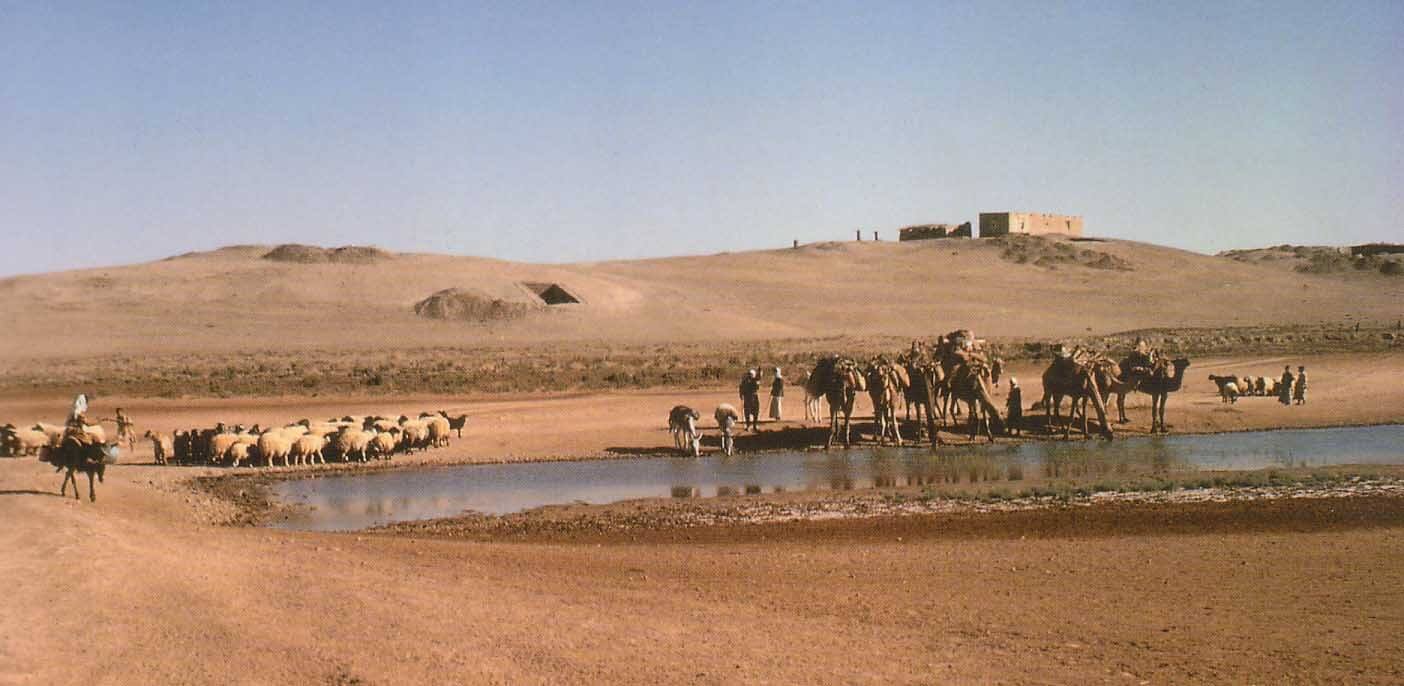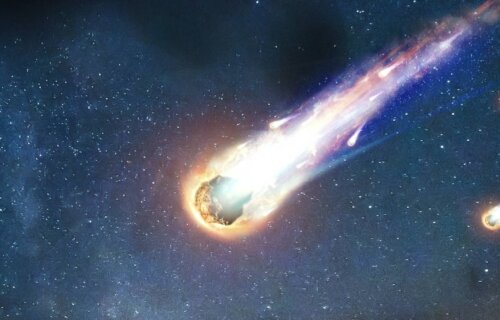SANTA BARBARA, Calif. — How did prehistoric humans go from hunting to farming? A new study finds they may have had some motivation from outer space. No, scientists aren’t talking about aliens — they’re referring to Earth’s chance encounter with an otherworldly space rock. A team from the University of California-Santa Barbara suggests that agriculture’s inception was the result of a cataclysmic event 12,800 years ago involving a fragmented comet’s collision with Earth’s atmosphere.
This cosmic explosion prompted environmental shifts that compelled the hunter-gatherers of the ancient settlement of Abu Hureyra, now within modern Syria, to turn to farming to enhance their survival prospects, according to the researchers. In a series of four interconnected papers, an international team of scientists explored the Younger Dryas Impact Hypothesis. This hypothesis postulates that a dramatic cooling of Earth nearly 13,000 years ago resulted from a cosmic impact.
“In this general region, there was a change from more humid conditions that were forested and with diverse sources of food for hunter-gatherers, to drier, cooler conditions when they could no longer subsist only as hunter-gatherers,” says Earth scientist James Kennett, a professor emeritus from UC Santa Barbara, in a university release.
The site of Abu Hureyra is renowned in archaeological circles for its evidence of the earliest shift from foraging to agriculture.
“The villagers started to cultivate barley, wheat, and legumes,” Prof. Kennett asserts.
Despite now being submerged under Lake Assad due to the 1970s construction of the Taqba Dam, Abu Hureyra yielded substantial materials for study before being flooded.
“The village occupants left an abundant and continuous record of seeds, legumes, and other foods,” explains Prof. Kent.

By analyzing the strata of remains, scientists distinguished the types of plants gathered during the pre-change warmer, humid period and the post-change cooler, drier period, marking the beginning of the Younger Dryas cool epoch.
Initially, the inhabitants’ diet comprised wild legumes, grains, and “small but significant amounts of wild fruits and berries.” After the climate shift, fruits and berries vanished from the diet, which transitioned to more domestic-type grains and lentils as early farming methods were explored.
A millennium later, all Neolithic “founder crops,” including emmer wheat, einkorn wheat, hulled barley, rye, peas, lentils, bitter vetch, chickpeas, and flax, were being cultivated in the region now known as the Fertile Crescent. Drought-resistant flora also became more common, indicative of the post-impact drier climate.
The researchers observed not only a “significant drop” in the population but also changes in the settlement’s structure, reflecting an agrarian shift, such as the initial confinement of livestock and other signs of animal domestication.
The researchers highlight that while agriculture emerged in various places during the Neolithic Era, it first appeared in the Levant — present-day Syria, Jordan, Lebanon, Palestine, Israel, and parts of Turkey — sparked by the severe post-impact climate conditions.
![Figure 2:Plant biogeographic responses to YD climate change in the Middle East. Darker green represents park-woodlands; greenish-tan represents arid steppes; reddish-tan represents desert terrain and largely unvegetated mountains. (A) Near the end of the Bølling-Allerød, park-woodlands grew close to Abu Hureyra and would have allowed the gathering of readily available fruits, nuts, and edible plants. (B) After the YD onset, arid steppes expanded and park-woodlands retreated ~200 km westward almost to the Mediterranean coastline more than 200 km west of Abu Hureyra, significantly changing available food resources. Images adapted and colorized from Figure 3.18 in Moore et al. [3] In assembling these maps, Moore et al. [3] and Hillman [74] used isopoll data from Huntley [75, 76], Huntley and Birks [77], Huntley and Webb [78], and Webb [79].](https://studyfinds.org/wp-content/uploads/2023/11/Climate-change-map.jpg)
The researchers believe that the airburst flattened trees and straw huts, splattered melted glass onto grains, buildings, tools, and animal bones, and likely injured humans as well.
A similar but smaller event was previously reported by the team, which they say destroyed the biblical city of Tall el-Hammam in the Jordan Valley around 1600 BC.
This “black mat” layer, along with nano-diamonds and melted minerals, has been identified at roughly 50 sites across the Americas and Europe, collectively referred to as the Younger Dryas strewn field. The findings suggest a “widespread” simultaneous destructive event, aligning with a fragmented comet’s impact on Earth’s atmosphere.
The aftermath — explosions, fires, and an ensuing “impact winter” — is believed to have led to the extinction of large animals, such as mammoths and saber-toothed cats, and the decline of the North American Clovis culture. According to the scientists, the aerial nature of the explosion accounts for the lack of craters.
The ongoing research focuses on compiling evidence of relatively lower-pressure cosmic explosions, akin to an airburst shockwave moving downward to Earth’s surface.
“Shocked quartz is well known and is probably the most robust proxy for a cosmic impact,” Prof. Kennett states, pointing out that the microscopic deformations within quartz sand grains — abundant in minerals from impact sites — are consistent with cosmic-level forces.
Furthermore, the “crème de la crème” of impact evidence, including characteristics shared between quartz from Abu Hureyra and nuclear test sites, has been found despite the absence of craters.
“For the first time, we propose that shock metamorphism in quartz grains exposed to an atomic detonation is essentially the same as during a low-altitude, lower-pressure cosmic airburst,” says Prof. Kennett.
The presented evidence in the study implies a novel link connecting extraterrestrial impacts with hemispheric environmental changes and significant shifts in human societies, including the advent of agricultural practices.
The papers are published in the journal Science Open: Airbursts and Cratering Impacts.
You might also be interested in:
- Scientists reveal new findings about the last day the dinosaurs roamed Earth
- Farming made our ancestors shorter, scientists discover
- Remains of an ancient planet found hiding inside Earth
South West News Service writer Stephen Beech contributed to this report.


Or possibly people have long been able to come up with new, useful ideas without being compelled to be emergencies.
“..BY emergencies…” Sorry.
Ocean impacts resulting in tsunamis, and
impacts in Seas, Lakes or Glaciers might not
Leave obvious primary craters (and possible
secondary craters might be debateable, because
of Lower impact velocities…) but witnesses
would still be affected, and would leave oral
histories possibly implicating divine heavenly
events (gods, Like Thor, perhaps),
some of them associated with what we now
call comets…
There is an alternative theory that the sun experiences reoccurring micro-nova events every 12,500 years or so.
During such events it becomes coated with particles, darkens, then explodes off the particles raining death throughout the solar system. We are overdue for the next event.
Probably Uluru mountain in Australia
Probably total bullshit, just like the adds on this site about Koshe getting arrested for revealing hi secret to making money.
As much as the scientists create reasons for this and that most of them seem never to agree
Every now and again we get new hypotheses about how we lived thru the ages.
Next month another study will find discover a new theory.
Sorry scientists but I am beginning to believe nothing.